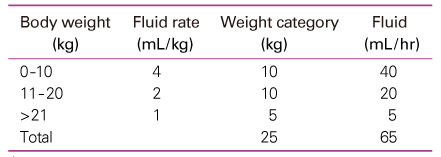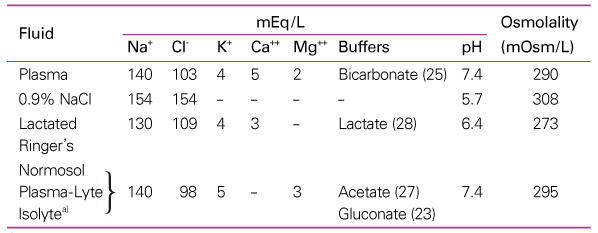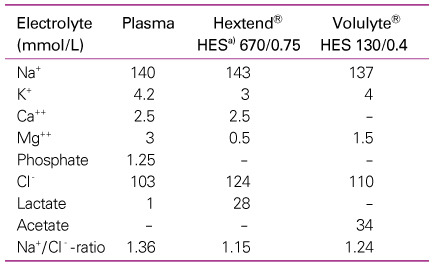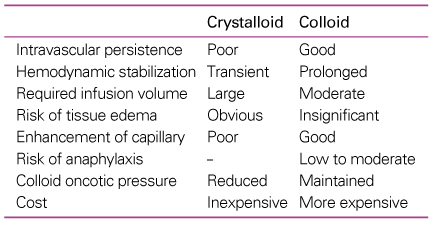 |
 |
- Search
| J Korean Med Assoc > Volume 53(12); 2010 > Article |
Abstract
Fluid and electrolyte therapies including nutritional support are markedly developing in medicine and many kinds of commercial fluids are being introduced to clinical practice. Understanding the characteristics and usefulness of intravenous fluids is necessary to manage patients properly. Disputes about the usefulness of crystalloid or colloid solutions for specific clinical conditions still continue. To make ideal fluid therapy possible, many kinds of fluids will be developed and applied to clinical practice in the near future by mimicking the composition and functions of human body fluids. The selection of crystalloid and colloid solutions for fluid therapy should be performed by considering patients' clinical and pathophysiological conditions and the characteristics and usefulness of each intravenous fluid.
References
1. Imm A, Carlson RW. Fluid resuscitation in circulatory shock. Crit Care Clin 1993;9:313-333.
2. Scheingraber S, Rehm M, Sehmisch C, Finsterer U. Rapid saline infusion produces hyperchloremic acidosis in patients undergoing gynecologic surgery. Anesthesiology 1999;90:1265-1270.
3. Prough DS, Bidani A. Hyperchloremic metabolic acidosis is a predictable consequence of intraoperative infusion of 0.9% saline. Anesthesiology 1999;90:1247-1249.
4. Griffith CA. The family of Ringer's solutions. NITA 1986;9:480-483.
5. Walker RH. Technical manual 1990;10th ed. Arlington (VA): American Association of Blood Banks.
6. Halpern NA, Alicea M, Seabrook B, Spungen A, Greenstein R. Isolyte S, a physiologic multielectrolyte solution, is preferable to normal saline to wash cell saver salvaged blood: conclusions from a prospective, randomized study in a canine model. Crit Care Med 1997;25:2031-2038.
7. Günther B, Jauch KW, Hartl W, Wicklmayr M, Dietze G, Heberer G. Low-dose glucose infusion in patients who have undergone surgery: possible cause of a muscular energy deficit. Arch Surg 1987;122:765-771.
8. Turina M, Fry DE, Polk HC Jr. Acute hyperglycemia and the innate immune system: clinical, cellular, and molecular aspects. Crit Care Med 2005;33:1624-1633.
9. van den Berghe G, Wouters P, Weekers F, Verwaest C, Bruyninckx F, Schetz M, Vlasselaers D, Ferdinande P, Lauwers P, Bouillon R. Intensive insulin therapy in the critically ill patients. N Engl J Med 2001;345:1359-1367.
10. Sieber FE, Traystman RJ. Special issues: glucose and the brain. Crit Care Med 1992;20:104-114.
11. Finney SJ, Zekveld C, Elia A, Evans TW. Glucose control and mortality in critically ill patients. JAMA 2003;290:2041-2047.
12. Griffel MI, Kaufman BS. Pharmacology of colloids and crystalloids. Crit Care Clin 1992;8:235-253.
13. Kaminski MV Jr, Haase TJ. Albumin and colloid osmotic pressure implications for fluid resuscitation. Crit Care Clin 1992;8:311-321.
14. Sutin KM, Ruskin KJ, Kaufman BS. Intravenous fluid therapy in neurologic injury. Crit Care Clin 1992;8:367-408.
15. Soni N, Margarson M. Albumin, where are we now? Curr Anaesth Crit Care 2004;15:61-68.
16. Halliwell B. Albumin: an important extracellular antioxidant? Biochem Pharmacol 1988;37:569-571.
17. Treib J, Baron JF, Grauer MT, Strauss RG. An international view of hydroxyethyl starches. Intensive Care Med 1999;25:258-268.
18. Jacob G, Raj SR, Ketch T, Pavlin B, Biaggioni I, Ertl AC, Robertson D. Postural pseudoanemia: posture-dependent change in hematocrit. Mayo Clin Proc 2005;80:611-614.
19. Vincent JL, Navickis RJ, Wilkes MM. Morbidity in hospitalized patients receiving human albumin: a meta-analysis of randomized, controlled trials. Crit Care Med 2004;32:2029-2038.
20. de Jonge E, Levi M. Effects of different plasma substitutes on blood coagulation: a comparative review. Crit Care Med 2001;29:1261-1267.
21. Nearman HS, Herman ML. Toxic effects of colloids in the intensive care unit. Crit Care Clin 1991;7:713-723.
22. Velanovich V. Crystalloid versus colloid fluid resuscitation: a meta-analysis of mortality. Surgery 1989;105:65-71.
- TOOLS
-
METRICS

-
Related articles in
J Korean Med Assoc -
Epidemiological characteristics of diabetes mellitus in Korea2022 October;65(10)
The classification, diagnosis, and treatment of rhinosinusitis2022 May;65(5)
Classification and diagnosis of vitiligo2020 December;63(12)
Introduction and characteristics of helicopter emergency medical services2020 April;63(4)
Classification and Characteristics of Mechanical Ventilator1997 April;40(4)










